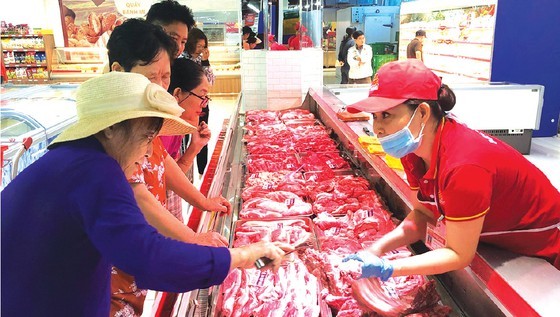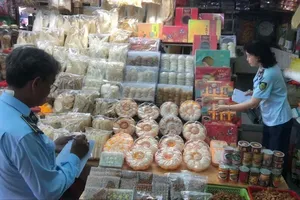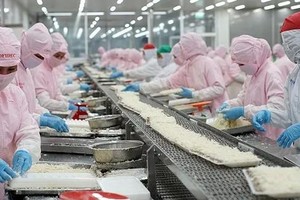
In addition, there was no shortage of pork or sudden hike in pork prices during Tet holidays.
Unlike previous years, consumers went shopping for Tet holidays quite early this year. By the date of Kitchen God Farewell Ceremony on January 17, or the 23rd day of the twelfth month in the lunar calendar, purchasing power had already increased heavily with many supermarkets and enterprises having achieved 70 percent of their targets at that time.
During the last week before the lunar New Year, the number of customers to supermarkets to buy fresh food, cattle meat, poultry meat, processed food, sweetmeat, vegetables, and fruits continued to hike. At some supermarkets, including Mega Market An Phu, Big C An Phu, and E Mart, customers constantly had to queue up at checkouts.
According to the unofficial data, purchasing power during Tet holidays rose by 10-15 percent over the same period last year, in which, purchasing power from modern distribution channels, such as supermarkets and convenience stores, surged by 20-30 percent.
However, some supermarket chains and stores saw an increase of merely 5 percent in purchasing power. Some enterprises said that they satisfied with such an increase amid a difficult economic situation. During the days near Tet, purchasing power at traditional markets grew by 30-40 percent compared to normal days.
From January 26 or the second day of the first month in the lunar calendar, some supermarkets, such as Co.opmart, convenience stores, including Vissan and Satrafood, and traditional markets have opened again but there were a few customers and purchasing power was poor. Convenience stores, including Circle K, and Shop&Go, still open all day to serve the diverse shopping demand of customers.
Goods have started to pour into wholesale markets in the city with a total amount of goods at nearly 3,000 tons per night, which were mainly vegetables and fruits.
At retail markets, most stalls closed for Tet holidays. There were a few traders selling cattle meat, poultry meat, vegetables, and fruits. The number of customers to traditional markets was not high.
Generally, the prices of goods during Tet holidays in Ho Chi Minh City were fairly stable. Especially, the essential food group, including cattle meat, poultry meat and eggs, and processed food, tended to slightly drop due to the influence of the price-stabilized goods, as well as a plentiful goods supply.
On January 22 and 23, at supermarkets, pork was piled up on shelves but purchasing power did not increase as heavily as expected so pork prices immediately were lowered by 10-20 percent. Similarly, at wholesale markets in the city, such as Hoc Mon Wholesale Market, the amount of pork arrived at the market increased strongly, reaching 622 tons per night, an increase of 68.1 percent compared to normal days so pork prices were fairly steady or slightly increased, depending on each meat cut.
It was recorded that a few essential goods groups were climbing sharply in the last three days before Tet, comprising of high-class fresh flowers and fruits whose prices doubled or tripled compared to normal days.
Particularly, the lily flower with five stems per bouquet was sold at VND350,000-VND500,000 per bouquet; tuberose was sold at VND200,000-VND250,000 per ten stems; gladiolus was sold at VND80,000-VND120,000 per ten stems; moth orchid was sold at VND200,000-VND250,000 per plant.
Due to unfavorable weather, two typical blossoms for the lunar New Year of the North and the South, namely peach blossom and ochna integerrima blossom, did not flower as expected so many growers have suffered huge losses this year.
Meanwhile, chrysanthemum stems were unsalable that traders had to dump their flowers.
As for fruits, including pomelo, soursop, and dragon fruit, their prices were 1.5 times higher than normal days as traders reduced supply while purchasing power was fairly high.
The first-grade Nam Roi pomelos fetched VND60,000-VND70,000 per kilogram; the first-grade green-skinned pomelos were sold at VND80,000-VND100,000 per kilogram; dragon fruits were priced from VND40,000 to VND60,000 per kilogram; honey mandarins were sold at VND70,000-VND80,000 per kilogram.
Other food products, such as chicken, snakehead fish, red tilapia fish, shrimp, and mackerel, saw an average increase of VND30,000-VND40,000 per kilogram in the prices.
Meanwhile, according to the price list of the Binh Dien Wholesale Market, the wholesale prices of most seafood products, and fruits were quite stable. Up to 30 percent of the products at the market lowered their prices by 7-40 percent compared to the same period last year.
From January 26 to 29, the prices of many products at supermarkets did not increase compared to the same period last year and were the same as those in normal days.
Particularly, at some supermarkets and food stores, the price of beef fluctuated from VND250,000 to VND300,000 per kilogram; the price of Vietnamese chicken was at VND120,000-VND140,000 per kilogram; the price of fish was from VND30,000 to VND120,000 per kilogram.
Supermarkets on the first opening day of this year also ran several promotional programs, of which, fresh food products were offered a discount of 10-20 percent while non-food products were lowered by 5-49 percent.
Unlike previous years, consumers went shopping for Tet holidays quite early this year. By the date of Kitchen God Farewell Ceremony on January 17, or the 23rd day of the twelfth month in the lunar calendar, purchasing power had already increased heavily with many supermarkets and enterprises having achieved 70 percent of their targets at that time.
During the last week before the lunar New Year, the number of customers to supermarkets to buy fresh food, cattle meat, poultry meat, processed food, sweetmeat, vegetables, and fruits continued to hike. At some supermarkets, including Mega Market An Phu, Big C An Phu, and E Mart, customers constantly had to queue up at checkouts.
According to the unofficial data, purchasing power during Tet holidays rose by 10-15 percent over the same period last year, in which, purchasing power from modern distribution channels, such as supermarkets and convenience stores, surged by 20-30 percent.
However, some supermarket chains and stores saw an increase of merely 5 percent in purchasing power. Some enterprises said that they satisfied with such an increase amid a difficult economic situation. During the days near Tet, purchasing power at traditional markets grew by 30-40 percent compared to normal days.
From January 26 or the second day of the first month in the lunar calendar, some supermarkets, such as Co.opmart, convenience stores, including Vissan and Satrafood, and traditional markets have opened again but there were a few customers and purchasing power was poor. Convenience stores, including Circle K, and Shop&Go, still open all day to serve the diverse shopping demand of customers.
Goods have started to pour into wholesale markets in the city with a total amount of goods at nearly 3,000 tons per night, which were mainly vegetables and fruits.
At retail markets, most stalls closed for Tet holidays. There were a few traders selling cattle meat, poultry meat, vegetables, and fruits. The number of customers to traditional markets was not high.
Generally, the prices of goods during Tet holidays in Ho Chi Minh City were fairly stable. Especially, the essential food group, including cattle meat, poultry meat and eggs, and processed food, tended to slightly drop due to the influence of the price-stabilized goods, as well as a plentiful goods supply.
On January 22 and 23, at supermarkets, pork was piled up on shelves but purchasing power did not increase as heavily as expected so pork prices immediately were lowered by 10-20 percent. Similarly, at wholesale markets in the city, such as Hoc Mon Wholesale Market, the amount of pork arrived at the market increased strongly, reaching 622 tons per night, an increase of 68.1 percent compared to normal days so pork prices were fairly steady or slightly increased, depending on each meat cut.
It was recorded that a few essential goods groups were climbing sharply in the last three days before Tet, comprising of high-class fresh flowers and fruits whose prices doubled or tripled compared to normal days.
Particularly, the lily flower with five stems per bouquet was sold at VND350,000-VND500,000 per bouquet; tuberose was sold at VND200,000-VND250,000 per ten stems; gladiolus was sold at VND80,000-VND120,000 per ten stems; moth orchid was sold at VND200,000-VND250,000 per plant.
Due to unfavorable weather, two typical blossoms for the lunar New Year of the North and the South, namely peach blossom and ochna integerrima blossom, did not flower as expected so many growers have suffered huge losses this year.
Meanwhile, chrysanthemum stems were unsalable that traders had to dump their flowers.
As for fruits, including pomelo, soursop, and dragon fruit, their prices were 1.5 times higher than normal days as traders reduced supply while purchasing power was fairly high.
The first-grade Nam Roi pomelos fetched VND60,000-VND70,000 per kilogram; the first-grade green-skinned pomelos were sold at VND80,000-VND100,000 per kilogram; dragon fruits were priced from VND40,000 to VND60,000 per kilogram; honey mandarins were sold at VND70,000-VND80,000 per kilogram.
Other food products, such as chicken, snakehead fish, red tilapia fish, shrimp, and mackerel, saw an average increase of VND30,000-VND40,000 per kilogram in the prices.
Meanwhile, according to the price list of the Binh Dien Wholesale Market, the wholesale prices of most seafood products, and fruits were quite stable. Up to 30 percent of the products at the market lowered their prices by 7-40 percent compared to the same period last year.
From January 26 to 29, the prices of many products at supermarkets did not increase compared to the same period last year and were the same as those in normal days.
Particularly, at some supermarkets and food stores, the price of beef fluctuated from VND250,000 to VND300,000 per kilogram; the price of Vietnamese chicken was at VND120,000-VND140,000 per kilogram; the price of fish was from VND30,000 to VND120,000 per kilogram.
Supermarkets on the first opening day of this year also ran several promotional programs, of which, fresh food products were offered a discount of 10-20 percent while non-food products were lowered by 5-49 percent.
























